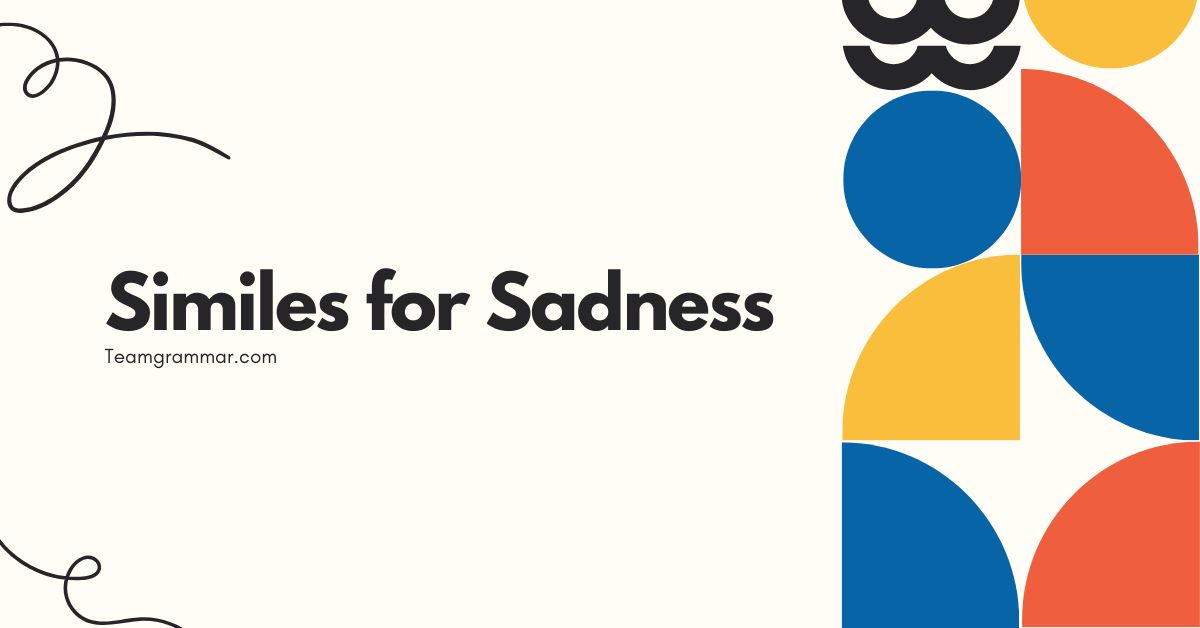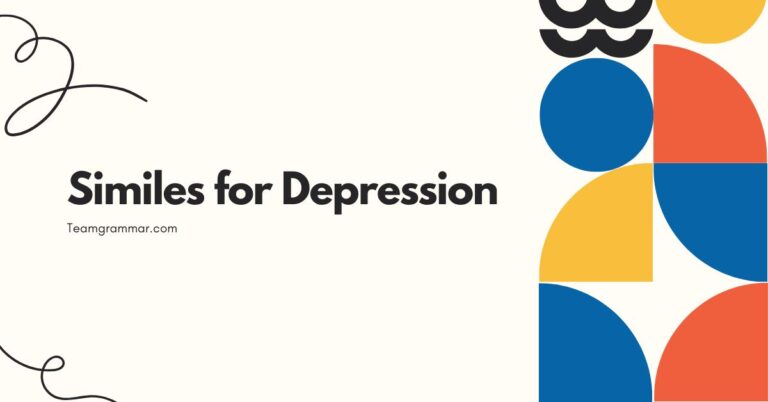37 Similes for Sadness: Enhancing Emotional Expression
Sadness is a complex human emotion that can be difficult to articulate. Similes, with their ability to draw comparisons, offer a powerful tool for expressing the nuances of sorrow.
This article explores the use of similes to depict sadness, helping writers and speakers convey depth and emotion in their language. Understanding and utilizing these similes enriches communication, allowing for more vivid and relatable descriptions of emotional states.
This guide is beneficial for students, writers, and anyone looking to expand their emotional vocabulary and improve their descriptive writing skills.
Table of Contents
- Introduction
- Definition of Simile and Sadness
- Structural Breakdown of Sadness Similes
- Types of Sadness and Corresponding Similes
- Examples of Similes for Sadness
- Usage Rules for Similes of Sadness
- Common Mistakes When Using Sadness Similes
- Practice Exercises
- Advanced Topics: Nuances and Subtleties
- Frequently Asked Questions
- Conclusion
Definition of Simile and Sadness
Asimileis a figure of speech that compares two unlike things using “like” or “as.” It’s a way to make descriptions more vivid and relatable by drawing parallels between something familiar and something less so. Similes help to paint a picture in the reader’s or listener’s mind, making the emotional impact more profound.
They are a staple of descriptive writing and poetry.
Sadness, on the other hand, is an emotion characterized by feelings of unhappiness, sorrow, and grief. It can range from mild disappointment to profound despair.
The expression of sadness varies greatly, from quiet withdrawal to overt displays of emotion. Understanding the different facets of sadness is crucial for effectively using similes to describe it.
Structural Breakdown of Sadness Similes
The basic structure of a simile is:A(the subject being described) +is like/as+B(the object of comparison). In the context of sadness, “A” is the person or situation experiencing sadness, and “B” is something that evokes or represents that feeling.
The strength of a simile lies in the aptness of the comparison. A well-chosen “B” can powerfully convey the depth and nature of the sadness.
For example, in the simile “She was as sad as a wilting flower,” “She” is the subject, “sad” is the emotion being described, and “a wilting flower” is the object of comparison. The image of a wilting flower effectively conveys the feeling of fragility and decline associated with sadness.
The effectiveness of the simile hinges on the reader’s understanding of what a wilting flower suggests: loss of vitality, beauty fading, and an overall sense of decline.
Types of Sadness and Corresponding Similes
Sadness isn’t a monolithic emotion; it comes in various forms, each with its own nuances. Using specific similes tailored to the type of sadness being described can greatly enhance the impact of your writing.
Let’s explore a few types of sadness and some similes that effectively capture them.
Deep Grief
Deep grief is an intense, overwhelming sadness often associated with loss. Similes that evoke heaviness, darkness, and emptiness are particularly effective.
Mild Disappointment
Mild disappointment is a lighter form of sadness, often resulting from unmet expectations or minor setbacks. Similes that suggest a slight letdown or a temporary setback are suitable.
Lingering Melancholy
Lingering melancholy is a persistent, low-grade sadness that can permeate one’s outlook. Similes that convey a sense of quiet sorrow or a subdued mood are appropriate.
Hopeless Despair
Hopeless despair is characterized by a sense of futility and the absence of hope. Similes reflecting emptiness, darkness, and the absence of light work well here.
Quiet Resignation
Quiet resignation is a subdued sadness accompanied by an acceptance of an undesirable situation. Similes that express a sense of inevitability and subdued sorrow are fitting.
Examples of Similes for Sadness
Here, we explore a variety of similes that can be used to express different shades of sadness. These are organized by the type of sadness they best represent, providing a diverse toolkit for your writing.
Similes for Deep Grief
The following table provides examples of similes that can be used to express deep grief. These similes often evoke images of heaviness, darkness, and emptiness.
| Simile | Explanation |
|---|---|
| As sad as a funeral dirge. | Evokes the solemnity and sorrow of a funeral song. |
| Like a heart weighed down by stones. | Illustrates the physical and emotional burden of grief. |
| As empty as a deserted house. | Conveys the feeling of emptiness and loss after someone is gone. |
| Like a sky perpetually overcast. | Suggests that the sadness is constant and unending. |
| As heavy as a leaden shroud. | Emphasizes the suffocating and oppressive nature of grief. |
| Like a ship lost at sea. | Represents the feeling of being lost and adrift in grief. |
| As dark as a moonless night. | Symbolizes the absence of hope and light in the midst of grief. |
| Like a silent scream. | Captures the intense, unspoken pain of grief. |
| As still as a graveyard. | Highlights the stillness and finality associated with death and loss. |
| Like a river of tears. | Represents the overwhelming outpouring of sadness. |
| As hollow as a broken promise. | Emphasizes the feeling of emptiness and betrayal. |
| Like a wilted rose, its beauty gone. | Symbolizes the loss of beauty and vitality due to grief. |
| As cold as a winter’s grave. | Conveys the chilling and isolating nature of grief. |
| Like a shadow that never leaves. | Represents the constant presence of grief. |
| As lost as a child in the woods. | Illustrates the feeling of disorientation and helplessness. |
| Like an echo of a forgotten song. | Represents the lingering memory of happier times. |
| As deep as an ocean trench. | Emphasizes the profound depth of the sadness. |
| Like a broken mirror, shattered and irreparable. | Symbolizes the feeling of being broken and unable to be fixed. |
| As numb as frostbite on skin. | Emphasizes the emotional numbness. |
| Like a tree stripped bare by winter. | Represents vulnerability after a loss. |
| As desolate as a barren wasteland. | Conveys the feeling of utter emptiness. |
| Like a bird with a broken wing. | Symbolizes the inability to move on. |
| As fragile as glass on the verge of shattering. | Emphasizes the intense vulnerability. |
Similes for Mild Disappointment
This table contains similes that capture the feeling of mild disappointment. These are less intense and often suggest a temporary setback.
| Simile | Explanation |
|---|---|
| As sad as a cancelled picnic. | Suggests a minor disappointment due to unforeseen circumstances. |
| Like a deflated balloon. | Conveys a feeling of being let down or losing excitement. |
| As flat as a day-old soda. | Implies a loss of fizz or excitement. |
| Like a rainy day at the beach. | Represents a situation where expectations are not met. |
| As dull as a blunt pencil. | Suggests a lack of sharpness or enthusiasm. |
| Like a missed opportunity. | Represents a feeling of regret over something that could have been. |
| As pale as a faded photograph. | Implies a loss of vibrancy or significance. |
| Like a slightly burnt toast. | Conveys a minor imperfection or setback. |
| As uninspired as a blank canvas. | Suggests a lack of creativity or motivation. |
| Like a puzzle with a missing piece. | Represents a feeling of incompleteness. |
| As lukewarm as forgotten coffee. | Implies a loss of interest or enthusiasm. |
| Like a cloudy summer day. | Suggests a slight disappointment on what should be a happy occasion. |
| As anticlimactic as a dud firework. | Emphasizes the feeling of unmet expectations. |
| Like a flat tire on a short drive. | Implies a small, but annoying setback. |
| As underwhelming as a weak cup of tea. | Suggests a lack of satisfaction. |
| Like a book with a predictable ending. | Conveys a feeling of boredom or lack of surprise. |
| As stale as yesterday’s bread. | Implies a loss of freshness or appeal. |
| Like a watered-down juice. | Suggests a diminished experience. |
| As quiet as the end of a party. | Emphasizes the end of excitement. |
| Like a swing set with no one to push. | Represents loneliness. |
Similes for Lingering Melancholy
The following table provides similes that can be used to describe lingering melancholy. These similes often convey a sense of quiet sorrow and a subdued mood.
| Simile | Explanation |
|---|---|
| As sad as a rainy Sunday afternoon. | Suggests a quiet, introspective sadness. |
| Like a faded photograph. | Conveys a sense of nostalgia and loss. |
| As muted as a distant song. | Implies a subdued and lingering sadness. |
| Like a gray sky on a winter day. | Represents a persistent, somber mood. |
| As quiet as a deserted street at dawn. | Suggests a sense of loneliness and stillness. |
| Like a shadow that follows you. | Represents the constant presence of sadness. |
| As wistful as an old love letter. | Implies a yearning for something lost. |
| Like a melody played in a minor key. | Conveys a subtle, melancholic tone. |
| As somber as a graveyard at twilight. | Suggests a quiet contemplation of mortality. |
| Like a forgotten melody. | Represents a sadness that lingers in the background. |
| As heavy as a heart full of unshed tears. | Implies a burden of unspoken sorrow. |
| Like a ship sailing without a destination. | Suggests a sense of aimlessness and sadness. |
| As still as a pond on a windless day. | Emphasizes stillness. |
| Like a forgotten book on a dusty shelf. | Implies loneliness. |
| As muted as colors in a dream. | Suggests a reality that is not vibrant. |
| Like a candle burning low. | Conveys a sense of fading energy. |
| As soft as the whisper of rain. | Implies calmness. |
| Like a gray filter over the world. | Suggests a sad outlook. |
| As haunting as a distant memory. | Emphasizes the power of the past. |
| Like a clock ticking in an empty room. | Represents loneliness and emptiness. |
Similes for Hopeless Despair
This table provides similes that can be used to express hopeless despair. These similes often reflect emptiness, darkness, and the absence of light.
| Simile | Explanation |
|---|---|
| As hopeless as a prisoner behind bars. | Suggests a complete lack of freedom and possibility. |
| Like a starless, endless night. | Conveys the absence of hope and light. |
| As empty as a bottomless pit. | Implies a profound and unfillable void. |
| Like a desert without an oasis. | Represents a barren and desolate existence. |
| As dark as the depths of the ocean. | Suggests an overwhelming and unknowable sadness. |
| Like a broken compass, leading nowhere. | Represents a loss of direction and purpose. |
| As desolate as a wasteland. | Implies a total lack of life and hope. |
| Like a flame extinguished by the wind. | Conveys the abrupt end of hope or possibility. |
| As silent as a world without sound. | Suggests a complete absence of joy and communication. |
| Like a ship without a rudder, lost at sea. | Represents a feeling of being adrift and without control. |
| As cold as a heart turned to stone. | Implies a complete lack of emotion and empathy. |
| Like a dream that turns into a nightmare. | Suggests a loss of innocence and hope. |
| As trapped as a fly in a spiderweb. | Emphasizes the lack of control. |
| Like a bird with clipped wings. | Implies the inability to reach goals. |
| As frozen as a statue in winter. | Suggests an inability to act. |
| Like a maze with no exit. | Conveys a sense of being lost. |
| As still as a stopped clock. | Implies that time has stopped. |
| Like a blank page in a diary. | Suggests the inability to write a future. |
| As hollow as a drum with a hole. | Emphasizes the emptiness. |
| Like a song with a broken record. | Represents being stuck in a cycle. |
Similes for Quiet Resignation
The table below contains similes that can be used to describe quiet resignation. These similes often express a sense of inevitability and subdued sorrow.
| Simile | Explanation |
|---|---|
| As sad as an old tree accepting its fate. | Suggests a quiet acceptance of decline and mortality. |
| Like a leaf falling in autumn. | Conveys a sense of natural and inevitable loss. |
| As still as a pond reflecting a gray sky. | Implies a quiet acceptance of a somber reality. |
| Like a sunset fading into night. | Represents a gentle and inevitable end. |
| As subdued as a whisper in a silent room. | Suggests a quiet and understated sorrow. |
| Like a worn path accepting the footsteps of time. | Represents an acceptance of the passage of time and its effects. |
| As resigned as a prisoner serving a life sentence. | Implies an acceptance of a difficult and unchangeable situation. |
| Like a river flowing to the sea. | Conveys a sense of inevitability and acceptance. |
| As calm as the eye of a storm. | Suggests a quiet acceptance amidst turmoil. |
| Like a candle slowly burning down. | Represents a gradual and inevitable decline. |
| As accepting as the earth receiving the rain. | Implies a natural and unquestioning acceptance. |
| Like a closing chapter in a long book. | Suggests the end of a significant phase. |
| As patient as the mountains. | Emphasizes the acceptance of time. |
| Like a clock winding down. | Implies inevitability. |
| As still as a statue in the rain. | Suggests acceptance. |
| Like a dancer taking her final bow. | Conveys a sense of closure. |
| As quiet as a library at night. | Implies peace. |
| Like a train arriving at its last station. | Suggests the end of a journey. |
| As soft as the fading light. | Emphasizes gentleness. |
| Like the last page of a story. | Represents the end. |
Usage Rules for Similes of Sadness
Using similes effectively requires understanding a few key rules. These guidelines will help you craft similes that are both evocative and grammatically sound, enhancing your writing and communication.
- Clarity: The comparison should be clear and easily understood. Avoid obscure or overly complex comparisons.
- Relevance: The object of comparison should be relevant to the type of sadness being described.
- Originality: While common similes can be effective, strive for originality to make your writing stand out.
- Consistency: Ensure the simile is consistent with the tone and style of your writing.
- Avoid Clichés: Try to avoid overused similes that have lost their impact.
Example of a Clear Simile: “He felt as blue as a stormy sea.” This is clear because everyone understands the connection between a stormy sea and feelings of sadness or turmoil.
Example of a Relevant Simile: “Her heart was like a lead weight after the bad news.” The lead weight effectively conveys the heavy, burdensome feeling of grief.
Example of Consistency: In a poem about nature, a simile like “sad as a wilting flower” fits well because it uses natural imagery.
Common Mistakes When Using Sadness Similes
Even experienced writers can make mistakes when using similes. Recognizing these common errors can help you avoid them and improve the quality of your writing.
- Mismatched Comparisons: Comparing things that have little in common.
- Overuse of Clichés: Relying on tired and unoriginal similes.
- Lack of Clarity: Using obscure or confusing comparisons.
- Inconsistency: Using similes that don’t fit the tone or style of the writing.
Incorrect: “He was as sad as a running shoe.” (Mismatched Comparison – running shoes don’t inherently relate to sadness.)
Correct: “He was as sad as a rainy day.” (Clear Comparison – rainy days are often associated with melancholy.)
Incorrect: “She was as sad as can be.” (Cliché – lacks originality and impact.)
Correct: “She was as sad as a songbird with a broken wing.” (Original and Evocative – creates a vivid image.)
Incorrect: “The sadness was like a quantum entanglement.” (Lack of Clarity – too technical and confusing for most readers.)
Correct: “The sadness was like a heavy fog, obscuring everything.” (Clear and Relatable – creates a clear image of overwhelming sadness.)
Practice Exercises
Test your understanding of similes for sadness with these practice exercises. Each exercise includes multiple questions to help you hone your skills.
Exercise 1: Identifying Effective Similes
Choose the most effective simile for expressing the given type of sadness.
| Question | Options | Answer |
|---|---|---|
| Which simile best expresses deep grief? | a) As sad as a cancelled picnic. b) Like a heart weighed down by stones. c) As flat as a day-old soda. | b) Like a heart weighed down by stones. |
| Which simile best expresses mild disappointment? | a) As dark as a moonless night. b) Like a deflated balloon. c) As still as a graveyard. | b) Like a deflated balloon. |
| Which simile best expresses lingering melancholy? | a) As sad as a rainy Sunday afternoon. b) Like a ship lost at sea. c) As cold as a winter’s grave. | a) As sad as a rainy Sunday afternoon. |
| Which simile best expresses hopeless despair? | a) As hopeless as a prisoner behind bars. b) Like a slightly burnt toast. c) As anticlimactic as a dud firework. | a) As hopeless as a prisoner behind bars. |
| Which simile best expresses quiet resignation? | a) As sad as an old tree accepting its fate. b) Like a broken mirror, shattered and irreparable. c) As numb as frostbite on skin. | a) As sad as an old tree accepting its fate. |
| Which simile best expresses a sudden loss of joy? | a) As desolate as a barren wasteland. b) Like a bubble bursting. c) As quiet as a deserted street at dawn. | b) Like a bubble bursting. |
| Which simile best describes a sadness that is overwhelming? | a) As deep as an ocean trench. b) Like a rainy day at the beach. c) As dull as a blunt pencil. | a) As deep as an ocean trench. |
| Which simile best describes a sense of isolation? | a) As alone as a single star in the sky. b) Like a melody played in a minor key. c) As heavy as a heart full of unshed tears. | a) As alone as a single star in the sky. |
| Which simile best portrays a sense of fading hope? | a) As faint as the last ember of a fire. b) Like a ship sailing without a destination. c) As somber as a graveyard at twilight. | a) As faint as the last ember of a fire. |
| Which simile best represents the feeling of being burdened by sadness? | a) As heavy as carrying the weight of the world. b) Like a swing set with no one to push. c) As quiet as the end of a party. | a) As heavy as carrying the weight of the world. |
Exercise 2: Completing Similes
Complete the following similes with an appropriate ending.
| Question | Answer |
|---|---|
| He was as sad as… | …a lone wolf howling at the moon. |
| Her heart felt like… | …a shattered vase after the argument. |
| The day was as gloomy as… | …a funeral procession. |
| His spirit was as broken as… | …a discarded toy. |
| She felt as lost as… | …a traveler without a map. |
| The news hit him like… | …a punch to the gut. |
| Her tears flowed like… | …a river after a storm. |
| His smile was as rare as… | …a sunny day in winter. |
| The room was as silent as… | …a tomb. |
| He carried his grief like… | …a heavy burden on his shoulders. |
Exercise 3: Writing Your Own Similes
Write your own similes to express the following emotions.
| Emotion | Your Simile |
|---|---|
| Profound Loneliness | As alone as the last tree standing after a forest fire. |
| Deep Regret | Like a constant ache in a phantom limb. |
| Overwhelming Disappointment | As crushing as a wave breaking over a sandcastle. |
| Quiet Desperation | Like a silent scream trapped inside. |
| Bittersweet Nostalgia | As poignant as a faded photograph of a loved one. |
| Stifled Grief | Like holding back a dam with your bare hands. |
| Unrelenting Sorrow | As persistent as the dripping of a leaky faucet. |
| Numbness | As detached as an astronaut floating in space. |
| Lost Hope | Like a wilting flower that never gets watered. |
| Lingering Sadness | As ever-present as the shadow of a tall building at sunset. |
Advanced Topics: Nuances and Subtleties
For advanced learners, exploring the nuances and subtleties of similes can elevate their writing to a higher level. This involves understanding the cultural context, emotional depth, and the power of suggestion within a simile.
- Cultural Context: Similes can be culturally specific. Understanding the cultural context of a simile can enhance its impact.
- Emotional Depth: Effective similes tap into deep emotional reserves, resonating with readers on a profound level.
- Power of Suggestion: The best similes don’t just describe; they suggest, allowing readers to draw their own conclusions and deepen their understanding.
Example of Cultural Context: A simile involving a specific type of local weather might resonate more deeply with people from that region.
Example of Emotional Depth: “His sadness was like a melody from his childhood, bringing back memories of loss and longing.” This simile evokes personal and profound emotions.
Example of Power of Suggestion: “Her eyes were as heavy as storm clouds.” This suggests not just sadness, but also the potential for an emotional outburst.
Frequently Asked Questions
Here are some frequently asked questions about using similes to express sadness.
- What’s the difference between a simile and a metaphor?
A simile uses “like” or “as” to make a comparison, while a metaphor states that one thing *is* another. For example, “He is *like* a lion” (simile) versus “He *is* a lion” (metaphor).
- How can I avoid using clichés when writing similes?
Strive for originality by thinking about unique comparisons that haven’t been overused. Consider personal experiences or unusual imagery.
- Can a simile be too complex?
Yes, if the comparison is too obscure or requires specialized knowledge, it may confuse readers and diminish the impact.
- How do I choose the right simile for a particular type of sadness?
Consider the specific nuances of the sadness you want to convey. Is it a deep grief, a mild disappointment, or a lingering melancholy? Choose a simile that aligns with that emotional tone.
- Is it okay to use multiple similes in one piece of writing?
Yes, but use them sparingly and purposefully. Overusing similes can make your writing feel cluttered and less impactful.
- How can I make my similes more vivid?
Use sensory details to enhance your comparisons. Describe the sights, sounds, smells, tastes, or textures associated with the object of comparison.
- What if I can’t think of a good simile?
Try brainstorming by listing different aspects of the sadness you want to express, then think of objects or situations that share those qualities.
- Are similes only useful in creative writing?
No, similes can be useful in any form of writing where you want to make a description more vivid or relatable, including journalism, essays, and even technical writing.
- Can similes be humorous?
Yes, similes can be used for humorous effect by creating unexpected or absurd comparisons. However, when describing sadness, it’s generally best to avoid humor unless it’s used very carefully and intentionally.
- How important is it to understand the object of comparison?
It’s crucial. If your readers don’t understand the object you’re comparing the sadness to, the simile will fall flat. Make sure your audience is familiar with the reference.
Conclusion
Mastering the art of using similes for sadness can significantly enhance your ability to express complex emotions in writing and speech. By understanding the different types of sadness, following usage rules, and avoiding common mistakes, you can craft similes that are both powerful and evocative.
Remember to strive for clarity, relevance, and originality in your comparisons. Experiment with different similes to find the ones that best capture the nuances of the emotions you want to convey.
With practice, you’ll be able to use similes to add depth, color, and emotional resonance to your writing.







